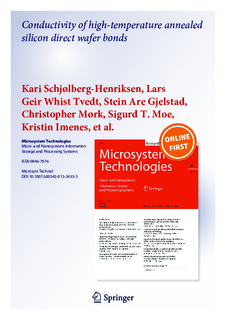| dc.contributor.author | Schjølberg-Henriksen, Kari | |
| dc.contributor.author | Tvedt, Lars Geir Whist | |
| dc.contributor.author | Gjelstad, Stein Are | |
| dc.contributor.author | Mørk, Christopher | |
| dc.contributor.author | Moe, Sigurd T. | |
| dc.contributor.author | Imenes, Kristin | |
| dc.contributor.author | Poppe, Erik | |
| dc.contributor.author | Wang, Dag Thorstein | |
| dc.date.accessioned | 2018-01-18T06:35:27Z | |
| dc.date.available | 2018-01-18T06:35:27Z | |
| dc.date.created | 2015-02-11T11:03:27Z | |
| dc.date.issued | 2015 | |
| dc.identifier.citation | Microsystem Technologies : Micro- and Nanosystems Information Storage and Processing Systems. 2015, 21 (5), 979-985. | nb_NO |
| dc.identifier.issn | 0946-7076 | |
| dc.identifier.uri | http://hdl.handle.net/11250/2478062 | |
| dc.description.abstract | Silicon direct wafer bonding is a process with many application areas. Depending on the application, perfect insulation or negligible resistance is desired across the bonded interface. We have investigated the resistivity of hydrophilic high-temperature silicon direct wafer bonds by measuring the resistance across bonded frames suitable for device encapsulation. Frame widths of 100, 200, and 400 µm were fabricated. Hydrophilic pre-bonded laminates resulted in strong bonds and a dicing yield above 89 % for frame widths of 200 µm or wider. The average resistance of dies from boron implanted laminates was 0.35–0.44 Ω, and the average resistance of dies from un-implanted laminates was 0.51–0.68 Ω. All resistances were independent of the bonding area, showing that the resistance of the bonded interface was negligible. Dies from boron implanted wafers had good Al–Si contacts and lower standard deviation of the resistance, indicating that the implantation improved the reliability of the electrical contacts. In the case of boron implanted laminates, the low resistance is explained by a discontinuous SiO2 and areas with continuous silicon lattice at the bonded interface. The results show that the oxide formed during silicon–silicon direct wafer bonding is broken up during bond annealing for 2 h at 1,050 °C, forming electrical connections of high quality between the two bonded wafers. | nb_NO |
| dc.language.iso | eng | nb_NO |
| dc.title | Conductivity of high-temperature annealed silicon direct wafer bonds | nb_NO |
| dc.type | Journal article | nb_NO |
| dc.type | Peer reviewed | nb_NO |
| dc.description.version | acceptedVersion | nb_NO |
| dc.source.pagenumber | 979-985 | nb_NO |
| dc.source.volume | 21 | nb_NO |
| dc.source.journal | Microsystem Technologies : Micro- and Nanosystems Information Storage and Processing Systems | nb_NO |
| dc.source.issue | 5 | nb_NO |
| dc.identifier.doi | 10.1007/s00542-015-2435-5 | |
| dc.identifier.cristin | 1220047 | |
| dc.relation.project | Norges forskningsråd: 210601 | nb_NO |
| cristin.unitcode | 7401,90,31,0 | |
| cristin.unitname | Mikrosystemer og nanoteknologi | |
| cristin.ispublished | true | |
| cristin.fulltext | postprint | |
| cristin.qualitycode | 1 | |
